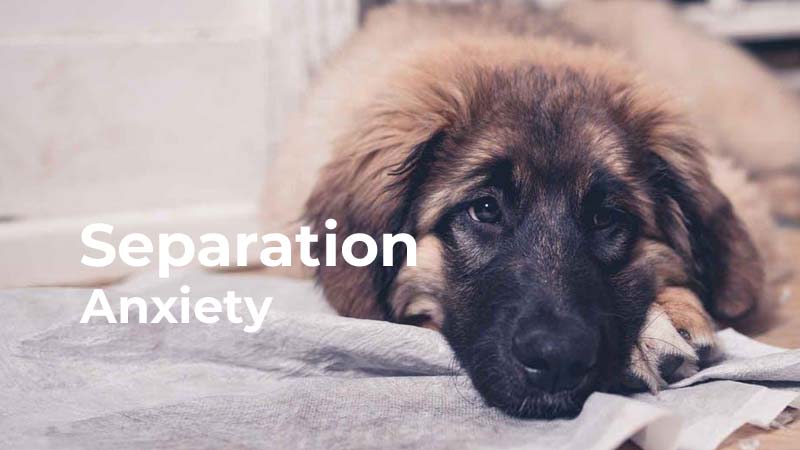- Size
- Smallest
- Small
- Small to Medium
- Medium
- Large
- Giant
- Characteristics
- Smartest
- Hypoallergenic
- Fluffy
- Best Guard
- Best Family
- Best for Kids
- Low Shedding
- Healthiest
- Police Dogs
- Most Calm
- Quietest
- Color
- White
- Black
- Grey
- Brown
- Blue
- Red
- Coat
- Hairless
- Short
- Long
- Origin
- Japan
- China
- Australia
- Germany
- Italy
- United States
- France
- Group
- Hound
- Terrier
- Herding
- Toy
- Working
- Sporting
Understanding and Addressing Separation Anxiety in Dogs

Dogs, known for their loyalty and companionship, can sometimes experience a challenging condition known as separation anxiety. It's a distressing scenario for both the dog and the owner, often resulting in destructive behaviors and stress-related issues for the furry friend. Recognizing the signs and implementing effective strategies can significantly improve the situation for both parties involved.
What is Separation Anxiety in Dogs?
Separation anxiety isn’t just about a dog missing its owner; it’s a distressing response triggered by separation. Common signs include vocalization, destructive chewing, inappropriate elimination, and other forms of destructive behavior. It’s important to differentiate between normal behaviors when left alone and genuine separation anxiety.
Signs of True Separation Anxiety
Anxiety at Departure: Dogs with separation anxiety often become anxious when they sense their owner preparing to leave. This anxiety can manifest in restlessness, panting, or pacing.
Immediate Misbehavior: Destructive behaviors occur shortly after the owner's departure, typically within the first 15 to 45 minutes. This includes behaviors like chewing, scratching doors, or excessive barking.
Constant Attachment: Dogs with separation anxiety might display clingy behavior, constantly following their owner around and seeking physical contact whenever possible.
Addressing Separation Anxiety: Strategies and Techniques
Tackling separation anxiety in dogs involves various strategies and techniques tailored to each dog's individual needs. Here's a detailed breakdown:
1. Gradual Desensitization
Gradual desensitization involves exposing the dog to brief periods of separation and gradually increasing the duration over time. This gradual approach helps the dog acclimate to being alone and reduces the stress associated with departures.
2. Behavior Modification Techniques
Positive reinforcement for calm behavior during departures and arrivals can be effective. This involves rewarding the dog for displaying calm and relaxed behavior when left alone.
3. Creating Positive Associations
Making departures less stressful by creating positive associations can aid in reducing anxiety. Providing special toys or treats exclusively during departure times can create a positive association with the departure routine.
4. Physical and Mental Stimulation
Ensuring dogs receive adequate exercise and mental stimulation is vital. Engaging them in activities like interactive play or providing puzzle toys can help keep their minds occupied and alleviate stress when alone.
5. Comforting Environment
Create a comforting environment by leaving familiar items like their favorite blanket or toys. Consider leaving a piece of clothing with your scent to provide comfort and familiarity in your absence.
7. Calm Departures and Arrivals
Avoid making departures and arrivals overly emotional. Keeping these moments calm and low-key helps to normalize the process of leaving and returning, reducing anxiety triggers for the dog.
8. Trial Runs and Consistency
Practice short departures frequently, gradually increasing the time away. Consistency in training methods is key; maintaining a routine helps dogs feel secure and minimizes anxiety triggers associated with departures.
9. Technology and Monitoring
Utilize technology such as cameras or monitors to observe your dog's behavior when left alone. This can provide insights into their behavior patterns and help evaluate the effectiveness of the strategies being implemented.
10. Seeking Professional Guidance
In severe cases, seeking guidance from a professional dog trainer or a veterinary behaviorist is highly recommended. They can develop a personalized treatment plan tailored to the specific needs of the dog, which may include behavioral therapy or, in extreme cases, medication.
Conclusion
Recognizing and managing separation anxiety in dogs is a challenging but crucial aspect of responsible pet ownership. By understanding the signs, employing appropriate strategies, and seeking professional guidance when needed, pet owners can help their furry companions overcome separation anxiety, leading to a happier and healthier relationship for both the dog and the owner.
Above all, patience is paramount. Changing behaviors and reducing separation anxiety takes time. Consistently reward positive behavior and avoid punishment, as it can worsen anxiety.
You May Also Like
 Dog BehaviorThe Reasons Behind Canine Digging and Effective Solutions
Dog BehaviorThe Reasons Behind Canine Digging and Effective Solutions Dog BehaviorUnderstanding Dog Chewing: Causes and Solutions
Dog BehaviorUnderstanding Dog Chewing: Causes and Solutions Dog BehaviorCommon Instigators of Excessive Dog Barking
Dog BehaviorCommon Instigators of Excessive Dog Barking Help & AdviceThe 6 Benefits of Chew Toys for Dogs
Help & AdviceThe 6 Benefits of Chew Toys for Dogs Help & AdviceHow To Keep Your Young Puppy From Eating Toys
Help & AdviceHow To Keep Your Young Puppy From Eating Toys Dog Toys & Puppy Toys7 Best Chew Toys For Lab Puppies (2022)
Dog Toys & Puppy Toys7 Best Chew Toys For Lab Puppies (2022)